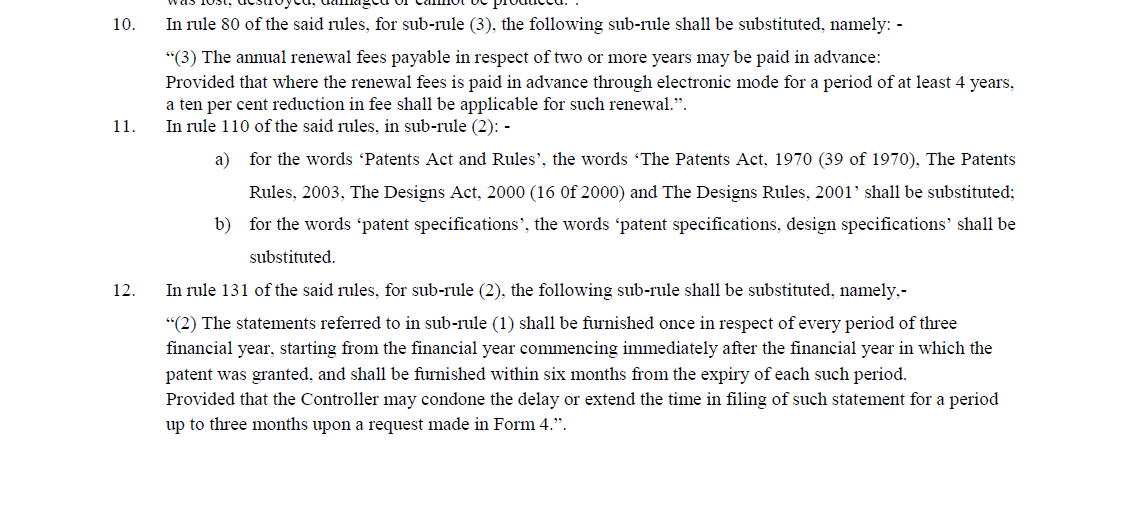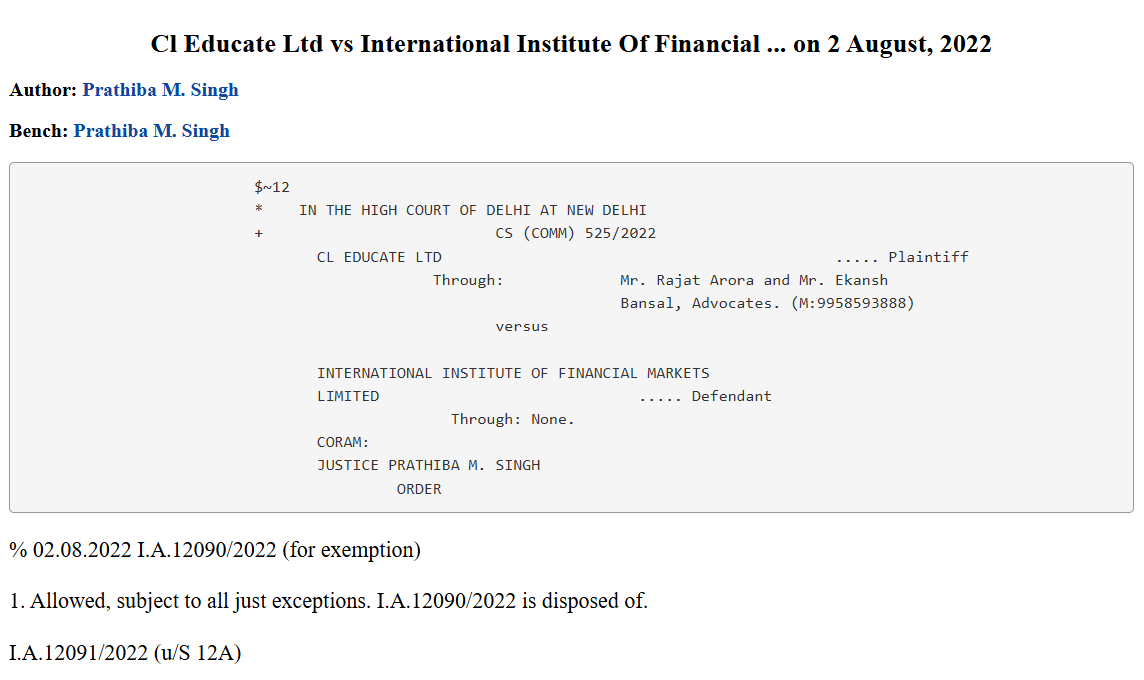Welcome to this edition of our newsletter!
Today, we delve into three pivotal amendments introduced by The Patents (Amendment) Rules, 2024. These changes aim to ease procedural burdens and reduce compliance costs for patentees, business owners, and decision-makers.
Let’s break down these amendments to help you navigate them effectively.
REDUCED RENEWAL FEE FOR THE PATENTEE
1. The Indian Government has amended the Rule 80 by substituting the existing sub-rule (3) with the new sub-rule (3) in the Rule 80.
“(3) The annual renewal fees payable in respect of two or more years may be paid in advance:
Provided that where the renewal fees is paid in advance through electronic mode for a period of at least 4 years, a ten per cent reduction in fee shall be applicable for such renewal.”
- With this amendment, the patentee will be able to avail the benefit of a reduced renewal fee for a granted patent, provided the patentee makes the advance payment of the renewal fee for at least 4 years through an electronic mode.
- The Government of India aims to reduce the administrative burden on patentees. Advance payments eliminate yearly renewal deadlines while offering reduced renewal fees.
- This amendment is also expected to increase Patent Office revenue. Although the fee is reduced, advance payments ensure sustained revenue, as patentees often forgo renewal due to uncertainties in patent commercialisation. The discounted option may incentivise advance payments, thereby boosting Patent Office revenue.
- This option is especially advantageous for the patentee during the latter years of a patent’s 20-year term because the quantum of reduced renewal fee would be substantial for the last years of twenty-year protection.
- Additionally, during commercialisation, such as licensing, advance payment of renewal fees reassures licensees. It signals the patentee’s commitment to maintaining the patent, reducing the risk of abandonment during the licensing agreement term.
REDUCED COMPLIANCE IN FILING THE WORKING STATEMENT OF THE PATENT
2. The Indian Government has amended the Rule 131 by substituting the sub-rule (2) with the new sub-rule (2) in the Rule 131.
“(2) The statements referred to in sub-rule (1) shall be furnished once in respect of every period of three financial year, starting from the financial year commencing immediately after the financial year in which the patent was granted, and shall be furnished within six months from the expiry of each such period.
Provided that the Controller may condone the delay or extend the time in filing of such statement for a period up to three months upon a request made in Form 4.”.
Prior to this amendment, the patentee has to furnish a statement of working of the patented invention before the Indian Patent Office every year before the 31st of March, i.e., before the expiry of the three months from the end of the calendar year. This amendment has made substantial changes, and the patentee must take note of these changes:
- Financial Year Vs Calendar Year: The reference point has shifted from a calendar year to a financial year in the newly substituted sub-rule (2) of Rule 131.
- Six Months From End of the Financial Year: Instead of three months from the calendar year’s end, patentees now have six months from the financial year’s end. This means they have until the end of September to file the working statement.
- File Once for three Financial years: Patentees are now required to file the statement of working only once for the preceding three financial years
- Three-Month Extension: Further, the patentee can seek an extension up to three months from the deadline date to file the statement of working of the patent. The patentee must be cautious while seeking an extension as the significant official fee of around USD 250 (Rs 20,000) PER MONTH would be levied when seeking an extension.
Implications:
This amendment significantly reduces the compliance burden and costs of filing the patented invention’s working statement. Further, it provides three additional years for the patentee to withhold the information corresponding to the working of the patented invention in India. Apparently, this amendment also limits transparency and public access to vital information. The long-term implications of this change—whether positive or negative—will unfold with time only.
INCLUSION OF THE DESIGNS ACT AND RULES FOR PATENT AGENT EXAMINATION
3. The Indian Government has amended Rule 110 to include The Designs Act, 2000 (16 0f 2000) and The Designs Rules, 20011 as a mandate for the candidates appearing for the examination for the Patent Agents
By incorporating design law, the examination ensures that future patent agents are well-equipped to handle both patents and design-related applications, bridging a crucial gap in expertise. This amendment marks a progressive step in enhancing the competency of patent agents. The upcoming Patent Agent Examination is scheduled for 05 Jan 2025. I wish the aspirants the best of luck.
CONCLUSION
These amendments reflect the Indian Government’s commitment to fostering a more efficient and patent-friendly environment. By addressing renewal costs, simplifying compliance, and broadening the expertise of patent agents, these changes pave the way for enhanced innovation management.
We’d love to hear your perspectives, particularly on the revised timelines for filing the patents’ working statements. Please share your views in the comments below, subscribe to our newsletter for more updates on intellectual property laws, and check out our YouTube channel for detailed discussions on these amendments.
Connect with a Legal Professional
Disclaimer: In compliance with the Bar Council of India guidelines, this article is intended for informational purposes only and does not constitute legal advice or a
solicitation for legal services.



